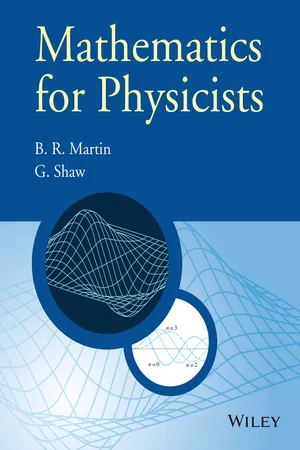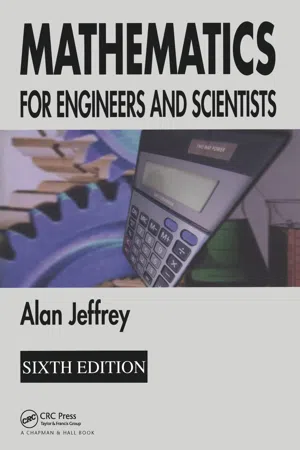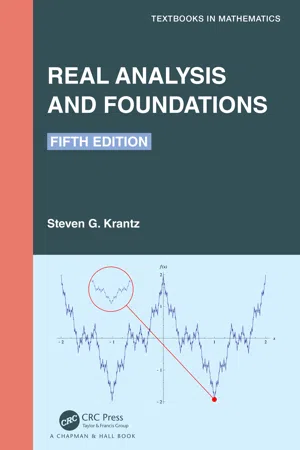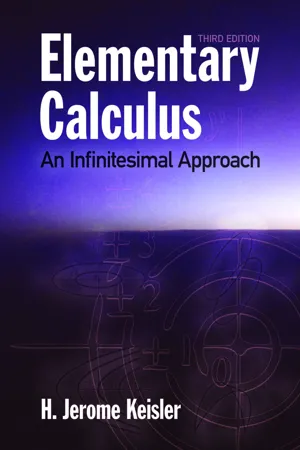Mathematics
Integration
Integration is a mathematical process that involves finding the accumulation of quantities. It is the reverse operation of differentiation and is used to calculate areas, volumes, and other quantities. In essence, integration allows us to find the total amount of something by adding up infinitely small parts.
Written by Perlego with AI-assistance
Related key terms
7 Key excerpts on "Integration"
- eBook - ePub
- Paul Turner, Justine Wood(Authors)
- 2023(Publication Date)
- Mercury Learning and Information(Publisher)
7INTEGRATIONDifferential calculus is concerned with finding the rate of change of a variable in response to changes in another variable. In graphical terms, we can think of the derivative as the slope of a tangent to a function at a point. Integral calculus , which we introduce in this chapter, also has a graphical interpretation as the process of finding the area under a curve between two points.7.1 DEFINITE IntegrationIn this section, we define the definite integral of a function between two points. This can be interpreted as the area under the curve between and where a and b are the lower and upper limits of Integration .Let us start with a very simple example. Suppose we have a function where c is a constant. This is probably the simplest function we can define in that the curve is simply a horizontal straight line in the Cartesian plane. Now suppose we want to find the area A under this curve between the values and The interval is referred to as the interval of Integration and the function is the integrand . The area A here is simply the area of the rectangle with height c and width equal to the change in x . We have a standard formula for such areas which we can easily calculate. In this case, we have Thus, the definite integral of the function between the lower limit and the upper limit , is simply equal to c .FIGURE 7.1 Area under the curve .Now let us consider a more complicated example. Suppose we wish to find the area under the curve between the values and as shown by the shaded area A in Figure 7.1 . We do not have a standard formula for the area under curves of this type, but we can approximate it using the following procedure. First, divide the interval to into four subintervals, each of which has length . Next, calculate the area of each of the rectangles whose height is the value of the function at the start of the interval and whose width is the distance - eBook - ePub
- Brian R. Martin, Graham Shaw(Authors)
- 2015(Publication Date)
- Wiley(Publisher)
4 Integral calculus We now turn from differentiation to the other crucial ingredient of the infinitesimal calculus, namely Integration. This may be approached in two ways: either as the inverse process of differentiation; or as the means of calculating the area under a given curve, using an argument that serves as a template for many other important applications. However, before discussing these, we must develop the above two approaches, and the relations between them. 4.1 Indefinite integrals Given a function f (x), the indefinite integral F (x) is defined as the most general solution of the equation (4.1) It is not unique. Suppose we have a particular solution F 0 (x), with (4.2) Then the most general solution can be written (4.3) where G (x) is any function such that (4.1) is satisfied. On substituting (4.3) into (4.1) and using (4.2), one obtains, and so G (x) = c, where c is a constant. Hence the indefinite integral is given by (4.4) where F 0 (x) is any particular solution of (4.1) and c is an arbitrary constant. An alternative way of writing the indefinite integral is (4.5) for reasons that will become clearer in the next section. Thus (4.4) is often written in the form (4.6) The process of determining the indefinite integral of a given function f (x) is called Integration, f (x) is called the integrand 1, and c the Integration constant. In simple cases, it can be done using the standard table of derivatives, Table 3.1, together with the basic properties (4.7a) or, more generally, (4.7b) which follow directly from the definition (4.1), where a, b are arbitrary constants and f (x) and g (x) are arbitrary functions. For example, from Table 3.1 we have and so deduce that and hence, using (4.7a), where. For the case n = −1, we can use the result from Table 3.1, so that (4.8) In this way, one builds up the table of standard indefinite integrals shown in Table 4.1, from which other integrals may be deduced using (4.7) - eBook - ePub
- Alan Jeffrey(Author)
- 2004(Publication Date)
- Chapman and Hall/CRC(Publisher)
The connection between differentiation and Integration is basic to the whole of the calculus and is contained in a result we shall prove later known as the fundamental theorem of calculus. Once again, limiting operations will play an essential part in the development of our argument. In fact we will show not only how they enable a satisfactory general theory of Integration to be established, but also how they provide a tool, albeit a clumsy one, for the actual numerical Integration of functions. However, aside from a number of simple but important examples, the practical details of the evaluation of integrals of specific classes of function will be deferred until Chapter 8. We begin by seeking to determine the shaded area I of Fig. 7.1 which is interior to the region bounded above and below by the curve y=f (x) and the x -axis, respectively, and to the left and right by the lines x = a,x = b. This approach will lead naturally to what is called the definite integral of f (x) over the interval a ≤ x ≤ b, and it illustrates a valuable geometrical interpretation of the process of Integration. Although we use the definite integral to give precise meaning to the notion of the area contained within a closed curve, this appeal to geometry is not actually necessary when defining a definite integral. Indeed, we shall also show how a purely analytical definition of a definite integral, quite independent of any geometrical arguments, may be formulated. Let f (x) be a non-negative continuous function defined in the closed interval [ a, b ] and consider, for a moment, the conceptual problem that arises when trying to determine the area I defined by it in Fig. 7.1 - eBook - ePub
- Steven G. Krantz(Author)
- 2022(Publication Date)
- Chapman and Hall/CRC(Publisher)
7 The Integral DOI: 10.1201/9781003222682-8 7.1 Partitions and the Concept of Integral We learn in calculus that it is often useful to think of an integral as representing area. However, this is but one of many important applications of Integration theory. The integral is a generalization of the summation process. That is the point of view that we shall take in the present chapter. Definition 7.1: Let [ a, b ] be a closed interval in ℝ. A finite, ordered set of points P = { x 0, x 1, x 2, …, x k − 1, x k } such that a = x 0 ≤ x 1 ≤ x 2 ≤ ⋯ ≤ x k − 1 ≤ x k = b is called a partition of [ a, b ]. Refer to Figure 7.1. Figure 7.1 A partition. If P is a partition of [ a, b ], then we let I j denote the interval [ x j − 1, x j ], j = 1, 2, …, k. The symbol Δ j denotes the length of I j. The mesh of P, denoted by m (P), is defined to be max j Δ j. The points of a partition need not be equally spaced, nor must they be distinct from each other. Example 7.2: The set P = { 0, 1, 1, 9 / 8, 2, 5, 21 / 4, 23 / 4, 6 } is a partition of the interval [0,6] with mesh 3 (because I 5 = [ 2, 5 ], with length 3, is the longest interval in the partition). See Figure 7.2. □ Figure 7.2 The partition in Example 7.2. Definition 7.3: Let [ a, b ] be an interval and let f be a function with domain [ a, b ]. If P = { x 0, x 1, x 2, …, x k − 1, x k } is a partition of [ a, b ] and if, for each j, s j is an element of I j, then the corresponding Riemann sum is defined to be ℛ (f, P) = ∑ j = 1 k f (s j) Δ j. Example. 7.4: Let f (x) = x 2 − x and [ a, b ] = [ 1, 4 ]. Define the partition P = { 1, 3 / 2, 2, 7 / 3, 4 } of this interval. Then, a Riemann sum for this f and P is ℛ (f, P) = (1 2 − 1) ⋅ 1 2 + ((7 / 4) 2 − (7 / 4)) ⋅ 1 2 + ((7 / 3) 2 − (7 / 3)) ⋅ 1 3 + (3 2 − 3) ⋅ 5 3 = 10103 864. □ Notice that we have complete latitude in choosing each point s j from the corresponding. interval I j - eBook - ePub
Elementary Calculus
An Infinitesimal Approach
- H. Jerome Keisler(Author)
- 2013(Publication Date)
- Dover Publications(Publisher)
4
Integration
4.1 THE DEFINITE INTEGRAL
We shall begin our study of the integral calculus in the same way in which we began with the differential calculus—by asking a question about curves in the plane.Suppose f is a real function continuous on an interval I and consider the curve Y = F(X). Let A < B where a, B are two points in I, and let the curve be above the x-axis for x between A and B; that is, f(x) ≥ 0. We then ask: What is meant by the AREA of the region bounded by the curve Y = F(x), the x-axis, and the lines x = A and x = b? That is, what is meant by the area of the shaded region in Figure 4.1.1 ? We call this region the region under the curve Y = F(X) between A and B.Figure 4.1.1The simplest possible case is where f is a constant function; that is, the curve is a horizontal line f(x) = k, where K is a constant and K ≥ 0, shown in Figure 4.1.2 . In this case the region under the curve is just a rectangle with height K and width B – a, so the area is defined asThe areas of certain other simple regions, such as triangles, trapezoids, and semicircles, are given by formulas from plane geometry.Figure 4.1.2The area under any continuous curve Y = f(x) will be given by the definite integral, which is writtenBefore plunging into the detailed definition of the integral, we outline the main ideas.First, the region under the curve is divided into infinitely many vertical strips of infinitesimal width dx. Next, each vertical strip is replaced by a vertical rectangle of height f(x), base dx, and area F(x) dx. The next step is to form the sum of the areas of all these rectangles, called the infinite Riemann sum (look ahead to Figures 4.1.3 and 4.1.11 ). Finally, the integral is defined as the standard part of the infinite Riemann sum.The infinite Riemann sum, being a sum of rectangles, has an infinitesimal error. This error is removed by taking the standard part to form the integral. - eBook - ePub
The Learning and Teaching of Calculus
Ideas, Insights and Activities
- John Monaghan, Robert Ely, Márcia M.F. Pinto, Mike Thomas(Authors)
- 2023(Publication Date)
- Routledge(Publisher)
Because Integration is such a central idea in calculus, all other big ideas in calculus relate to it in … integral ways. There is benefit for us all, students and teachers alike, to be curious about such relationships, which only stand to deepen our understanding of this rich subject. 5.1 Comments on selected Mathematters Mathematter Building on the demonstration in Figure 5.6, make as general a conjecture as possible about the kind of curves for which Riemann sums give arbitrarily good estimates for the area bounded by the curve. That is, what conditions guarantee that a curve is Riemann integrable on a domain? The technique works whenever the function has bounded variation on a domain – the total amount it goes up and down is finite. When this happens, the domain can be partitioned into intervals on which the function is monotone and this technique applied. This condition can be weakened – for instance, here is a function with unbounded variation, but for which the Riemann integral can be defined: f (x) = x sin 1 x ln x 2 on [ 0, 1 ] (with f (0) = 0). Mathematter Try Fermat’s approach for the area under y = 1 / x 2 x = p to ∞(positive p). Pick r > 1 and partition the domain at the points p, pr, pr 2, pr 3, etc. Find the Riemann sum, use a geometric series to write it in closed form. Then let r. A left-sided Riemann sum for such a partition is given by, (p r − p) 1 p 2 + p r 2 − p r 1 (p r) 2 + p r 3 − p r 2 1 p r 2 2 + … which simplifies to r − 1 p 1 + 1 r + 1 r 2 + ⋯ = r − 1 p 1 1 − 1 r = r p As r → 1, this approaches 1 p. Mathematter Can every antiderivative. of r be seen as an accumulation function for r ? It is possible for F to be an antiderivative of f but yet for there to exist no a such that F (x ^) = ∫ a x ^ f (x) d x. For instance, F (x) = 1 3 e 3 x + 500 is an antiderivative for, but not an accumulation function for, f (x) = e 3 x. The problem is that f only has way less than 500 area total under it between x = – ∞ and 0 - eBook - ePub
- Cinzia Bisi, Rita Fioresi(Authors)
- 2024(Publication Date)
- Chapman and Hall/CRC(Publisher)
x-axis, it is enough to change the sign and compute the definite integral. However, for a function, which is not continuous, we may lose this geometric interpretation. In the next observation, we take into exam an example of this situation. These reasonings should be taken as an opportunity to think deeper into concepts, regarding Integration, that we are unable to fully explore in our discussion.Observation 4.1.2 The definition of definite integral is given through the concept of limit; however, we know that, in general, a limit may not exist. Indeed, we are going to see an example of a bounded function in a closed interval for which the lim∆→0 Rn does not exist, and hence, it is not possible to compute its definite integral in such interval.Consider the Dirichlet function f : [0, 1] → ℝ:f ( x ) ={1x rational0x irrationalDepending on how we choose the points t1 , . . . , tn in the intervals [xi , xi+1] ⊂ [0, 1], we have that:- Rn = 1, if we choose all ti rational,
- Rn = 0, if we choose all ti irrational.
We have an important result, whose proof is in Appendix 4.12 .Proposition 4.1.3 A continuous function is integrable in a closed interval.Hence, all the most interesting functions in applied sciences, such as polynomial, rational, algebraic, exponential and trigonometric functions that we studied in Chapter 1 , are integrable in every closed interval in their domain.At this point, however, we should not assume that continuity is a necessary condition to have integrability; we will see an example in the next section (Example 4.2.3).The definition of integral is not very helpful for actual computations; let us see an example on how we can apply directly the definition to compute a very simple integral. We will see, later on, much more effective methods for computing integrals.Example 4.1.4 We want to compute the integral of f(x) = x from 0 to 1. From the elementary geometry, we know that the area between the line y = x and the x-axis, for x in the interval [0, 1], is the area of a right triangle with two sides equal to 1. So, our geometric and intuitive reasoning shows that the definite integral of f(x) = x is 1/2. Let us proceed now to the calculation through the definition. We take ∆i = (1 − 0)/n = 1/n as the width of the intervals and calculate Rn taking the point xi as the left end-point of the ith
Learn about this page
Index pages curate the most relevant extracts from our library of academic textbooks. They’ve been created using an in-house natural language model (NLM), each adding context and meaning to key research topics.






